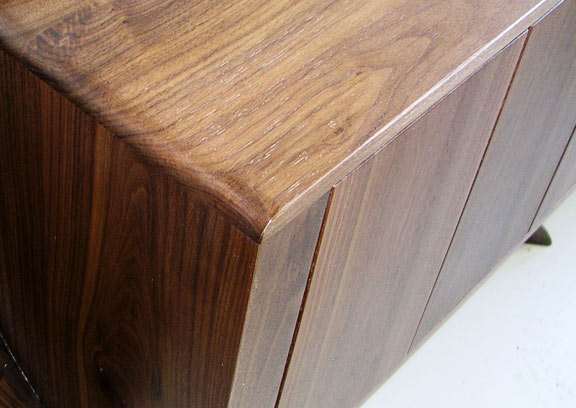Cleaning White Sanding Dust out of the Wood Grain
Advice on keeping white dust out of wood grain when sanding a finish coat smooth. May 17, 2010
Question
I have a client that likes me to wet sand his final coat with Abralon 500 grit sanding pads. I spray Campbells Duravar. Often itís an open grained dark wood such as walnut. So I do the sanding with mineral spirits and then I wash the surface with a clean saturated rag of spirits. I rub with a clean soft cloth, blow it off, and still end up with the white dust in the grain. For my own work I only steel wool my final coat with wool lube and that gives me no problems but he likes the sanding pads. He excepts the dust in the grain, but I think it looks terrible. I have spoken to a couple of finishing experts and they didnít have any advice worthwhile, so does anyone else have any thoughts?

Click here for higher quality, full size image
Forum Responses
(Finishing Forum)
From contributor M:
Sanding pads create larger bits of the finish than does the steel wool. Sounds to me like the sanding pads are creating visible particles of the dried finish and they are settling in the woodgrain. I have this problem sometimes. A check would be to re-spray an area (test piece) that has the white showing, and see if the white disappears by melting into the new coat. If it does, that means it is not a foreign contamination, but particles of the finish you previously sanded. I use tack rags to remove most of my sanding residue, but still doesn't get it all. This won't solve your problem, but you will narrow down where it is coming from.
From contributor J:
If you used a pore filler first, there would be no place for the sanding dust to collect. Of course the final appearance would be different, so he may not like that. Maybe skipping the wet rag wipedown and letting the sanding slurry dry first. Then blow it out hard with compressed air, right at the pores. This would be very tedious to do.
From contributor Y:
Are you sanding by hand with the grain or machine sanding? Use mineral oil instead of mineral spirits. Then use a rubbing brush (3-4 row) with the grain to get the compacted dust/oil out of the grain. You may need to repeat after itís dry. You can use MS to clean off the sanding residue. You need a stiffer brush that will do the job without disturbing the finish.
From contributor J:
I'm mostly rubbing by hand but he wants me to use a machine - so letís say both. Even if it's not bothering him it is bothering me. I will look into the brush and mineral oil.
From contributor S:
How long after final coat are you waiting for cure before you begin to sand?
From the original questioner:
Two days.
From contributor W:
Finishing is dealing with taste, that could be different for many people. I have the similar experience about white dust in the grain. I put a thin glaze over the finish and let the glaze went into and color the pores. Let it dry then clean up the glaze in the surfaces with steel wool and re-coat the finish.
From the original questioner:
Well just because the client does not care much about it I do and it's important to keep to my standards. I understand a client may want something that is not working out for you but if they want it and they are happy then so be it.
From contributor S:
Try waiting another day or two before you sand. Before sanding butter the piece up real well with the baby oil so that the pores are filled with the oil which should help block the sanding dust that is being ground in deep when you use a free solvent. Don't let the dust sit in the pores over night.
